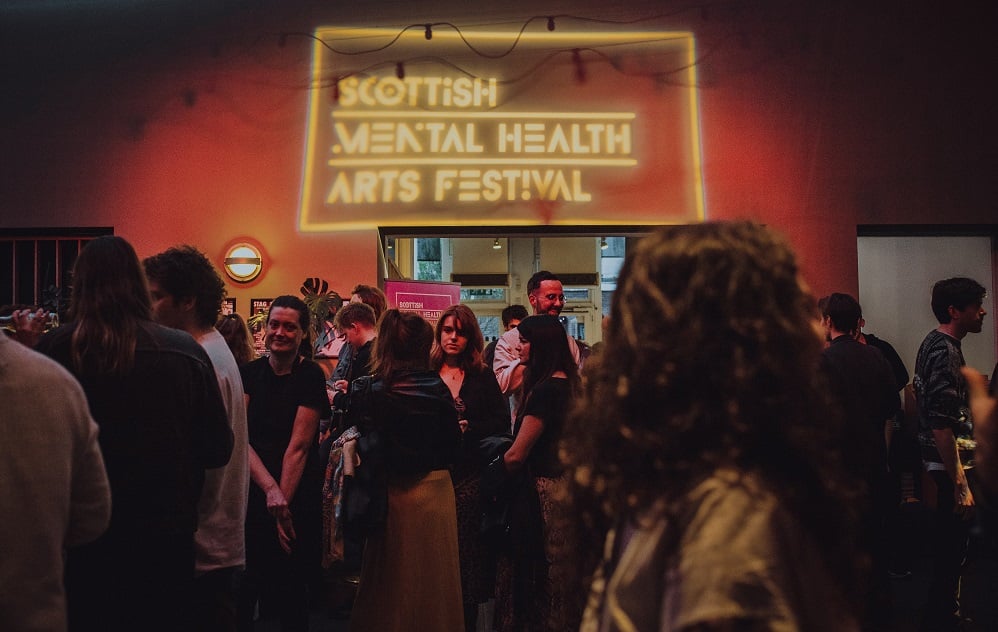
The Scottish Mental Health Arts Festival
Photo: Courtesy of the Mental Health Foundation Scotland
The arts and mental health: a vibrant field flying under the radar
David Cutler explains why the Baring Foundation will be supporting this flourishing yet sometimes precarious area of work in a major new funding programme.
In recent weeks, many of us have been moved and inspired to see neighbourhoods in Italy singing together from their balconies to form choirs on locked down streets.
These scenes demonstrate the power of the arts to provide comfort and support in difficult times – something that I have recently had the great privilege and pleasure to witness in many other contexts. Over the last year I have visited or spoken to over one hundred organisations involved in creative activity with people with mental health problems. The conclusions from my explorations have now been published in our new mapping study, ‘Creatively Minded’. It forms the backdrop to the Baring Foundation’s new arts funding programme as we move this year from a decade of support for creative ageing.
In some ways what I found out was a surprise. Our initial soundings made us think that there wasn’t remotely so much happening, even though it was an important area deserving more support. In fact, I found a complex web of over 170 organisations. This is certainly an underestimate of overall activity: the report excludes a number of areas, including qualified arts therapy. Why was our initial impression on the scale of activity so misleading?
For us, creativity is a human right. Other benefits, though significant, are secondary
In my view, it may be because even people who have been dedicated to this work for decades are usually only familiar with a few organisations working locally. Coming together to share experiences is not easy, because of the complexity of the provision models: there are many different types of organisation involved. These may include specialist arts and mental health providers, more generalist participatory arts agencies, recovery colleges, community centres using artists, museums and very occasionally, larger arts organisations like orchestras. There are linking networks, but these generally fly under the broader flag of ‘arts and health’, even when most of their work is around mental health.
So despite the increased public attention on mental health and the welcome atmosphere of greater openness in society, the significant role of this impressive body of work isn’t getting the attention, profile and acclaim it deserves.
A second home
The great majority of the organisations I contacted were small, often with two to four workers and perhaps a handful of freelance artists. Their funding was almost invariably stretched, leaving workers feeling that the charity was hanging on in there – even though many had survived for 20 to 30 years. This is a further source of stress in what can be challenging work. The most frequent point I heard from artists was the need to dedicate more time and resources to self-care as a way of better serving participants. Funding came from a wide variety of sources, cobbled together with all the ingenuity of the arts sector. Very little work was commissioned from the health sector.
It was clear to me, though, how deeply valuable this work was in the lives of participants. For many it was a second home, providing a weekly place of community, achievement, understanding and fun.
In it for the long haul
The huge expansion of social prescribing, especially in England, is an opportunity for those involved in arts and mental health, but also a challenge as to how systems and stretched resources can meet greatly increased demand.
Now the Baring Foundation needs to decide how we can play our part in supporting this deeply valuable system of arts and mental health work. This will be difficult and it is inevitable that we will disappoint many people. We know that our own resources are modest – around £1m a year – and we are keen to join forces with others. We want to be genuinely open and continue to learn from the field, so our approach will evolve. For us, creativity is a human right. Other benefits, though significant, are secondary. We will work across the UK and across art forms. And we are in it for the long term: our previous art programme lasted for a decade. We will make our first announcement about funding opportunities around the middle of the year.
I want to finish with a quotation from the foreword to our report. It’s from Dolly Sen, a wonderful artist with mental health problems:
“Art became the roadmap back to myself. As my creativity evolved I grew as a person, art became a way of life and then my career. It has also given me armour and a shield to face the world, making a sometimes ugly world a little more tolerable, a world beautiful enough to save my soul. I cannot capitulate. I can only create.”
David Cutler is Director of the Baring Foundation.
![]() baringfoundation.org.uk
baringfoundation.org.uk
![]() @Baring_Found
@Baring_Found
Join the Discussion
You must be logged in to post a comment.